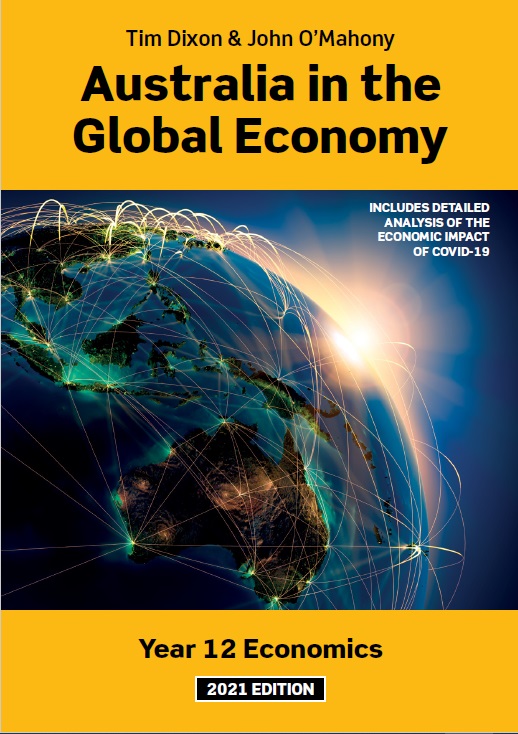Australia In The Global Economy, 2021 Edition
By Tim Dixon and John O’mahony

Table of contents
TOPIC 1 THE GLOBAL ECONOMY
Chapter 1 Introduction to the Global Economy
1.1 The global economy 4
1.2 Globalisation 5
1.3 The international and regional business cycles 17
Chapter 2 Trade in the Global Economy
2.1 Advantages and disadvantages of free trade 23
2.2 Reasons for protection 25
2.3 Methods of protection 28
2.4 Trade agreements 32
2.5 International organisations 39
2.6 Government economic forums 44
Chapter 3 Globalisation and Economic Development
3.1 Introduction 48
3.2 Differences in income and economic growth 49
3.3 Differences in economic development 51
3.4 Categories of development in the global economy 54
3.5 Causes of inequality in the global economy 56
3.6 The impact of globalisation 64
COVID-19: The economic dimensions of a global pandemic 75
Case Study: Brazil 77
Case Study: Indonesia 91
TOPIC 2 AUSTRALIA’S PLACE IN THE GLOBAL ECONOMY
Chapter 4 Australia’s Trade and Financial Flows
4.1 Understanding Australia’s place in the global economy 108
4.2 Trends in Australia’s trade patterns 108
4.3 Trends in Australia’s financial flows 113
4.4 The balance of payments 114
4.5 Trends in Australia’s balance of payments 120
4.6 The consequences of a high CAD 128
Chapter 5 Exchange Rates
5.1 Introduction 133
5.2 Australia’s floating exchange rate system 134
5.3 Reserve Bank intervention in the foreign exchange market 140
5.4 Fixed exchange rate systems 142
5.5 Exchange rates and the balance of payments 143
Chapter 6 Protection in Australia
6.1 Introduction 148
6.2 Government initiatives to reduce protection 149
6.3 Australia’s free trade agreements 151
6.4 Implications of a reduction in protection levels for the Australian economy 153
6.5 The impact of international protection levels on Australia 157
6.6 The future of Australian industry in the global economy 160
TOPIC 3 ECONOMIC ISSUES
Chapter 7 Economic Growth
7.1 Introduction 166
7.2 Economic growth and aggregate demand and supply 167
7.3 The components of aggregate demand 168
7.4 Changing levels of growth: the multiplier process 171
7.5 The role of aggregate supply 174
7.6 The effects of economic growth 175
7.7 Recent economic growth trends 177
7.8 Policies to sustain economic growth 181
COVID-19: The impacts on the Australian economy 185
Chapter 8 Unemployment
8.1 Introduction 187
8.2 Measuring the level of unemployment 187
8.3 Recent unemployment trends 189
8.4 The main types of unemployment 191
8.5 The non-accelerating inflation rate of unemployment 194
8.6 The causes of unemployment 195
8.7 The impacts of unemployment 199
8.8 Policies to reduce unemployment 202
Chapter 9 Inflation
9.1 Introduction 208
9.2 Measuring the rate of inflation 208
9.3 Recent trends in inflation 210
9.4 The main causes of inflation 211
9.5 The effects of inflation 214
9.6 Policies to sustain low inflation 216
Chapter 10 External Stability
10.1 Introduction 220
10.2 Australia’s current account deficit 221
10.3 Australia’s foreign liabilities 225
10.4 Australia’s exchange rate 228
10.5 Policies to achieve external stability 231
Chapter 11 Distribution of Income and Wealth
11.1 Introduction 235
11.2 Measuring the distribution of income and wealth 236
11.3 Sources of income and wealth 240
11.4 Trends in the distribution of income and wealth 242
11.5 The costs and benefits of inequality 250
11.6 Government policies and inequality 255
Chapter 12 Environmental Sustainability
12.1 Introduction 261
12.2 Ecologically sustainable development 262
12.3 Market failure: private benefits and social costs 263
12.4 Public and private goods 266
12.5 Major environmental issues 266
12.6 Government policies and environmental sustainability 272
TOPIC 4 ECONOMIC POLICIES AND MANAGEMENT
Chapter 13 The Objectives of Economic Policy
13.1 Introduction 278
13.2 The objectives of economic management 278
13.3 The goals of government policy in 2021 281
13.4 Conflicts in government policy objectives 284
13.5 The economic policy mix 285
Chapter 14 Fiscal Policy
14.1 The meaning of fiscal policy 289
14.2 Budget outcomes 290
14.3 Changes in budget outcomes 292
14.4 Methods of financing a deficit 295
14.5 The current stance of fiscal policy 298
14.6 The impact of recent fiscal policy 302
Chapter 15 Monetary Policy
15.1 Introduction 310
15.2 The objectives of monetary policy 311
15.3 The implementation of monetary policy 313
15.4 The impact of changes in interest rates 318
15.5 The stance of monetary policy in Australia 321
Chapter 16 Microeconomic and Environmental Policies
16.1 Microeconomic policies and aggregate supply 326
16.2 Microeconomic policies and individual industries 329
16.3 Environmental management policies 336
Chapter 17 Labour Market Policies
17.1 Introduction 345
17.2 The role of national and state industrial systems 346
17.3 Australia’s wage determination system 347
17.4 Dispute resolution 353
17.5 Decentralisation of the labour market 355
17.6 Education, training and employment programs 357
17.7 Evaluating labour market outcomes in Australia 361
Chapter 18 Effectiveness and Limitations of Economic Policy
18.1 An overview of the effectiveness of economic management 365
18.2 Limitations of economic policy 370
18.3 Evaluating the effectiveness of specific policies 375
APPENDICES
Appendix A Key Economic Skills
A.1 Introduction 384
A.2 Drawing and interpreting economics diagrams 386
A.3 Equations and calculations in economics 391
A.4 Interpreting economic data and information 393
Appendix B Advanced Economic Analysis
B.1 Comparative advantage and gains from trade 396
B.2 Income-expenditure diagram 400
B.3 Long-run Phillips curve 402
B.4 Limitations of macroeconomic policy 404
Glossary 407
Index 420
